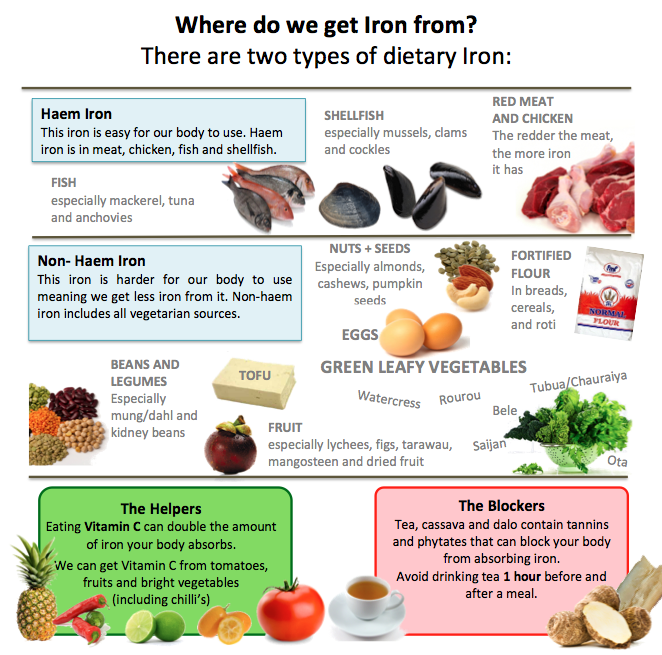Iron and Anaemia
Identifying Iron Deficiency Anaemia.

What you eat can make a difference between
weak and strong, healthy blood.
By - Jeffrey So, Volunteer Dietitian Nutritionist.
Ever wonder why you or your children come across as tired, weak and lethargic, or feeling frequent headaches, dizziness or hard to concentrate, it could be a sign of anaemia.
People who are anaemic can also present with pale skins, eyelids and gums as well as hair loss. The word ‘anaemia’ in Greek literally means “without blood”. It is a condition when you have fewer red blood cells than normal or less haemoglobin (red colour in blood) in red blood cells than normal. The leading cause of anaemia in Fiji is iron deficiency which could arise from inadequate iron intake or excessive loss of iron from the body.

Iron - is an important nutrient that helps carrying oxygen in haemoglobin through our blood to different parts of the body. Our organs (like the brain, heart and muscle) need oxygen to keep us fuelled and energised. The risk of iron-deficiency increases when there is a loss of blood, such as women with heavy menstrual flows. Iron-deficiency is also prevalent amongst children experiencing growth spurts or pregnant women when there is an increased demand.
In Fiji, 50% of children under 5 have iron deficiency anaemia, and 25% of children between 5-11 years! Around 40% of women also have anaemia due to iron deficiency. These are big numbers, considering this could affect our ability to focus, weaken our immune system making us more susceptible to illness and infection, and can even delay development in infants and children.
How much iron do we need?
|
AGE |
AMOUNT |
AGE |
AMOUNT |
||
| INFANTS | 7-12 mths | 11 mg/day | MEN | >19 yo | 8 mg/day |
| CHILDREN |
1-3 yo 4-8 yo |
9 mg/day 10 mg/day |
WOMEN |
19-50 yo >50 yo |
18 mg/day 8 mg/day |
| BOYS |
9-13 yo 14-18 yo |
8 mg/day 11 mg/day |
PREGNANT WOMEN |
19-50 yo | 27 mg/day |
| GIRLS |
9-13 yo 14-18 yo |
8 mg/day 15 mg/day |
LACTATING WOMEN |
14-18 yo 19-50 yo |
10 mg/day 9 mg/day |
*Source: Nutrient References values for Australia and New Zealand
Where can we get iron from?
Fiji is a country full of bountiful, varied and cheap foods that are naturally rich in iron; therefore it’s not hard to incorporate them into our diet.

Iron Content of Selected foods:
Food Item Iron Content
| Chicken – 100g | 1.5 mg |
| Beef – 100g | 3.3 mg |
| Pork – 100g | 1 mg |
| Reef Fish – 100g | 1 mg |
| Sardines – 100g | 3 mg |
| Tuna in cans – 100g | 1 mg |
| Eggs – 1 medium | 2 mg |
| Mussels – 100g | 6.3 mg |
| Clams – 100g | 27.5mg |
| Dhals, split peas – 1 cup | 3 mg |
| Taro leaves - 1 cup | 5 mg |
| Bele 1 cup | 4 mg |
| Tubua/ Chauraiya 1 cup | 6 mg |
| Chinese cabbage -1 cup | 3 mg |
|
Bread/Roti made with fortified flour – 1 piece |
1 mg |
| Red kidney beans – 1 cup | 3 mg |
| Figs – 5 pieces | 2 mg |
| Dried fruits – 30g | 1 mg |
| *Source: Pacific Food Composition Table |
|
Tips to prevent iron deficiency anaemia:
|
This article is not a substitute for proper medical diagnosis or dietary advice. Always seek health professionals at your nearest hospitals/health centre for further information.